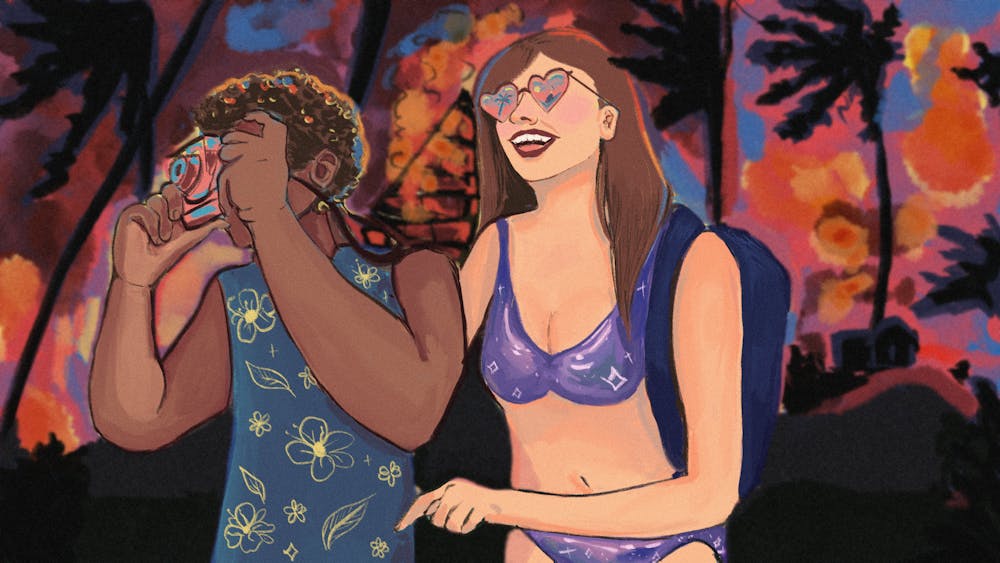Rage is a powerful thing. But way too often, when it is unleashed by marginalized folks, organizers, or even students, this rage is weaponized against those communities.
We see this manifest hyper–locally within our Penn community, a prime example being the Penn administration’s insistent union–busting efforts as an attempt to suppress student rage. These struggles connect to wider national and international efforts: America’s complicity in the Maui wildfires.
In early August of this year, a series of destructive, growing wildfires broke out on the island of Maui, Hawai'i, leaving 115 people dead, hundreds more missing, and thousands displaced. This makes the Maui fires one of the deadliest in United States history, yet we have strayed from the source of such devastation.
Western media fails to account for the historical and ongoing colonization issues plaguing Maui. For Americans, Hawai'i is the 50th state of this country. But many do not know how the Indigenous land was violently, forcibly, and visciously occupied and later seized to be codified under the US government. This colonial legacy continues to aggressively pervade the Native Hawaiian people and culture: the tourism industry's exploitative efforts, major corporations’ infiltration and expansion of their business expeditions, and multi–millionaires' missions to destroy native land to build their next vacation homes.
Hawai'i or the Native people of Hawai'i are rarely, if ever, afforded nuance. The people and the island are perpetually oversimplified as America’s paradise. This land is perceived as merely disposable and fantasized—a sheer experience to the Western tourist.
To understand the tourism industry’s monopolistic efforts in sustaining this parasitical relationship between tourists and Indigenous Hawaiians, we must first recognize that Hawai'i is a sovereign kingdom that has been dismantled by white colonists. The sheer ecology and culture of Hawai'i’s land have been violently altered and cleared for the practice of monoculture, most notably demonstrated through the cultivation of sugar plantations starting in the early 19th century. The sugar plantation industry in Hawai'i has created dramatic, unrectifiable change to the environment. An example of these changes includes the implementation of water diversion tactics, in which opportunistic settlers irreversibly altered major Hawaiian rivers’ natural flow in order to supply irrigation to soil–rich, arid, and sunny areas (such as Central Valley in Maui). Additionally, the killing of native ulu trees, under the jurisdiction of white settlers, has destroyed the land’s native, symbiotic relationships (in this case, the ulu trees are essential in providing necessary moisture for dry regions).
Therefore, there is no neutrality in tourism when this industry continues to extract these resources. The deforestation and eradication of Native species to construct resorts and vacation homes or the severe overpopulation (where tourists outnumber residents six to one and outnumber Indigenous Hawaiians by 30 to one) are neither accidental nor impartial to colonialism. These realities coupled with foreign investment have encouraged tourism, intensifying the rate of inflation and increasing the cost of living, which has translated into the ongoing housing crisis that disproportionately affects Native people. All while Indigenous folks struggle to find homes or are being forcibly displaced due to the wildfire, dozens of celebrities can still lavishly boast their multi–million–dollar mansions and expand their landowning aspirations.
In Maui’s case, the poorly managed infrastructure, the lack of ecological diversity, and the strong winds induced by climate change are all ingredients for the devastating wildfires. Therefore, it is undoubtedly natural for Indigenous folks to rise with rage. Rage in every strain is necessary for change, and we too must foster a community of rage when we are organizing and demanding change.
This rage also reminds us of the importance of caring and how to care meaningfully. Today's society molds us to view our relationships with some form of a transactional purpose and the power of storytelling becomes a marketing tool for profit. In other words, caring becomes capitalized. And in this case for Maui, the rage by Indigenous people of Hawai'i has been substituted by something that sells: conspiracy theories. Western pop culture never fails to regurgitate fascist propaganda to divert attention from the devastation of the Maui fires—one example being the outlandish theory that the fires were caused by a secret “energy weapon.”
Rather than utilizing social media as a means to center the crisis and raise support and funds for the Maui people, it has become a space for social media sleuths to “solve the mystery” of what caused the fires. Western media platforms and users have taken space only to falsely deflect the story into a viral 60–second TikTok consumed by millions of users everywhere, silencing and suppressing rage.
As consumers of pop culture and social media, we can also replicate this harmful behavior, whether that is by spreading misinformation or indulging in luxury island vacations that play a role in sustaining capitalist exploitation. As Penn students in West Philadelphia, we too must recognize the need to react with rage. Rage is what creates change and fosters care.
We can share this care with our campus, West Philadelphia, and even all the way to the people of Hawai'i. We have to take this rage we all have and recognize it. Cultivate it. React to it. And most importantly, care about it.
Ways to donate and support the people of Maui:







